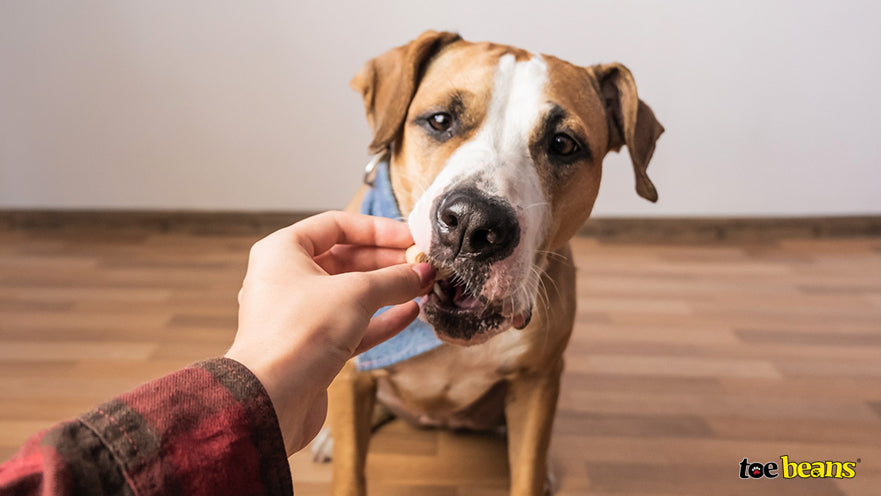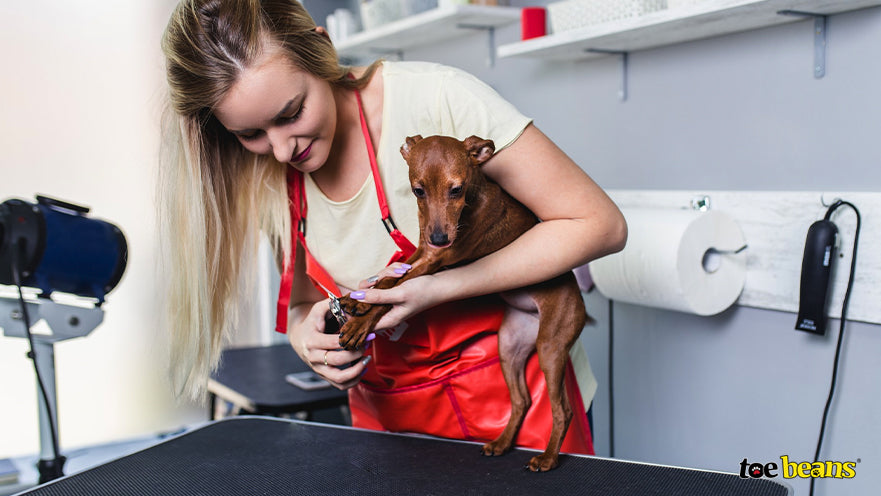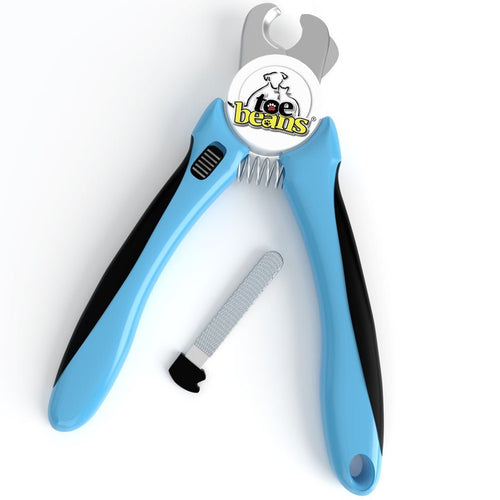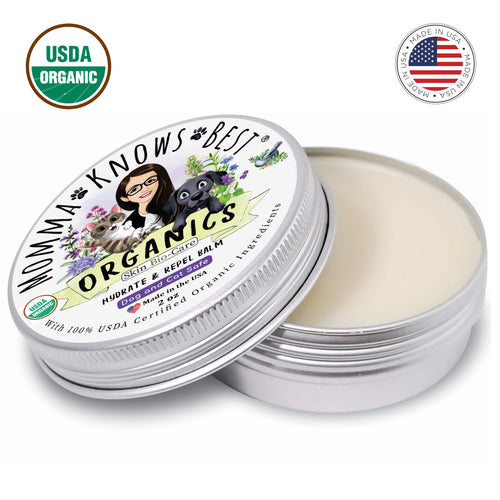Your Cart is Empty
Free 2-5 day delivery | No minimum purchase required
Free 2-5 day delivery | No minimum purchase required
Shop
Learn
[Guide] How to Train Your Dog to Let You Clip Their Nails
 by K Marie Alto Updated
11 min read 2 Comments
by K Marie Alto Updated
11 min read 2 Comments

When your fingernails or toenails get too long, you clip them back.
It's part of regular grooming and everyday life. Just like you, your dog's nails will grow and need trimming from time to time.
Unfortunately, many dogs dislike having their nails clipped and avoid it or fight back when you try. How can you train your dog to let you clip his nails?
You may have seen the viral videos of people wrapping their heads in plastic wrap, smearing it with peanut butter, and using it to distract their pup while they trim.
The truth is, you don't need to go to those lengths, but you may need to invest some time in training.
In this post a discuss everything about training your dog to let you clip their nails. From dog psychology, to using the right type of dog nail clippers to how to make sure to clip properly (this section comes with a bonus)!
As usual my blog is packed with resources. For pet parents looking for more dog care guides, I have listed some great guides at the bottom. I'm sure you will learn a thing or two that will improve your dog's life.
Let's dig in!
Editor's Note: '[Guide] How to Train Your Dog to Let You Clip Their Nails' was originally written in 2021. We update this post periodically to reflect changes in techniques, new recommendations, and because I am always learning new things!
Table of Contents
- Understanding Your Dog's Reaction
- Get the Right Tools
- Make Sure to Clip Properly
- Start Puppies Young
- Train Them to Have Their Paws Held
- Associate Treats and Excitement with Clippers
- Practice With Another Object
- Bring a Friend to Sooth Your Pal
- Consider Emery Board Training
- Avoid Restraint, Muzzles, and Force
- Can I Give My Dog Benadryl to Cut His Nails?
- The Groomer Option
- Keep On Trimming
Understanding Your Dog's Reaction
Any time you're interacting with an animal, it can help if you understand why they act the way they do.
Is their action an ingrained biological reaction or a quirk of their physiology? Is their behavior related to something in their psyche?

The truth is, many dogs have had a bad experience with nail clipping, and that makes them averse to future clippings. A dog's nail is really a claw, which has blood vessels and a nerve that runs down the center.
Learning how to train your dog to let you clip their nails is a must have skill for every pet parent. If you've ever clipped your nails too far and cut off a bit of the skin beneath, you understand that it hurts and can be irritating for days until it heals.
Well, a dog's claw is the same way; if you clip too deep, it cuts that nerve and hurts. Your dog will then associate nail clipping with toe pain and won't let it happen anymore.
Understandable, right?
Unfortunately, this can often happen when a puppy is young before you've adopted them. Much like any other bad habit, you can train your dog to be a bit easier going when you're clipping nails, but it may take some time.
Some parents may be tempted to try to "genius" 🤓 hacks like the ones in the video below. While funny, we highly discourage this approach.
Get the Right Tools
The first step to train your dog to let you clip their nails is to get the right tools. There are two kinds of nail trimmers for dogs: clippers and grinders. Clippers are similar to human nail clippers.
They're a manual tool you use to cut the nails, one snip at a time. They can be tricky to position, especially if your dog is antsy or nervous.
Grinders are like Dremel tools for nails. They're essentially high-speed files and can grind down a nail quickly.
They work pretty well, but they're noisy. Some dogs hate the noise or the vibration of having their nails ground, and you want to make sure you're not scaring your pup.
Our tips:
- Get a new tool. Your dog might associate the device with the unpleasant experience of a scary nail trim, and a new tool might be less triggering, particularly a different kind of tool. Additionally, new clippers can be sharper and better for cutting nails quickly and smoothly.
- Consider changing types. Clippers and grinders have their pros and cons, and neither is a clear winner.
We discuss the best nail clippers in greater detail here if you're curious to learn more.
Recognizing when your dog’s nails are too long is as important as getting the right tools. And while every dog is different and will exhibit different signs, fortunately, there are some clear signs common among most dogs.
The easiest sign to spot is the clicking sound of nails on hard floors—this usually evidences they’re touching the ground and need trimming.
The second one is If your dog’s nails start curving. This is another sign they’re overgrown and may even begin to press into the paw pad.
A third one is if you notice changes in your dog’s posture or gait. Such changes may be due to discomfort from long nails that impact their balance and mobility.
Make Sure to Clip Properly
The number two thing to do when trimming your dog's nails is to make sure you're cutting them properly.
As we mentioned, many dogs are avoidant of trimming because of bad past experiences. You'll want to make sure to avoid contributing another bad experience.

Whether you're using clippers or grinders, you can pinch the quick, crack a nail, or grind too deep, all of which cause pain and lead to avoidant behavior.
Your ultimate goal is to trim the nails short enough so that they don't touch the floor when your dog is walking. Unfortunately, there's no easy way to do this, especially if you've let your dog's nails get too long. The quick – that nerve in the nail – grows out with the nail.
Only the outer few millimeters of the nail are safe to trim, so make sure not to trim beyond that to avoid causing any unnecessary pain. Check out our blog post on how to find the quick when trimming black or white dog nails for more details.
If your dog has excessively long nails, you'll need to trim them in stages. Trim a bit off the ends, then wait a few days. The nerve and blood flow in the nail will recede, leaving it free for another trim once it has healed. You'll need to trim every 3-4 days until your pup's nails are the desired length.
Err on the side of too little to avoid hurting your fur baby! Otherwise, you're just setting back their training even more.
However, as a rule of thumb, never start a pawdicure session without having handy a natural styptic powder. We highly recommend a natural option as chemical-based options contain harsh chemicals that will harm your pup.
Save $1 PLUS free shipping when you bundle The Clawper Pro with Momma Knows Best Organic 3-in-1 Styptic Powder. Use coupon code: Clawperbundle. This coupon is only valid for the bundle.
Start Puppies Young
If possible, start your dogs with nail training when they're young. Like all training, it's easier to reinforce good behavior and break bad habits when your dog is young and not set in its ways.

Of course, it's never too late to start! Older dogs with more ingrained habits may need a more extended, slower training period before they're more accustomed to letting you trim their nails. Take your time, and don't push them beyond their comfort zone.
Train Them to Have Their Paws Held
Part of nail clipping is simply training your pupper to let their paws be held. Some dogs don't mind this, while others do.
Train them to shake or hold out their feet for your handling, and hold them as if you were going to trim their nails. Don't bring clippers into the equation yet, though!

You may need to offer a high-value treat as an incentive for this training. After all, your goal is to encourage your dog and convince them that it's safe and pleasant to have their paws held.
Teach them a command, hold their paw, then give them a treat. Repeat as necessary to build the appropriate association.
If your dog has a significant adverse reaction to their paws being handled, you may need to work on counter-conditioning.
Whole Dog Journal offers a rundown here of a counter-conditioning program that can convince your dog to allow themselves to be touched in as little as a few weeks. As usual, it depends on the attitude and history of your particular pup.
Associate Treats and Excitement with Clippers
Part of conditioning your canine companion to accept nail trimming is associating the clippers or grinder themselves with positive outcomes.
One way to do this is to bring out the clippers, show them to your dog, and give them a treat. Don't try to trim or even bring the clippers near the paws just yet.

All you're doing is associating the clippers with treats. To quote Whole Dog Journal:
"A counter-conditioning protocol might start with simply picking up the clippers (or grinder) in one hand and feeding the dog a very high value treat from the other – and this is repeated until the act of picking up the clipper makes your dog's tail wag and eyes light up as he searches for the expected goodie. You gradually move the clipper toward the dog, eventually touching him with it, all the while working to maintain the positive association: nail clipper/grinder makes really good stuff happen!"
This process might take a few weeks or a month, but it's well worth the effort. Often, it might only take a week or two of spending 5-10 minutes a day on training, and your dog will be more than happy to see the clippers come out.
Practice With Another Object
You can use an eraser, a marker, or another small object to simulate clipping without actually clipping nails. Once you've trained your dog to have their paws handled, start adding stimulus to the training.
You don't need to do anything harsh; tap or put a little pressure on a nail before letting the paw go.

All you're doing is training your dog to accept something happening to their paw while you hold it while proving that the "something" isn't going to hurt them or be unpleasant.
After all, if you're trimming their nails properly, the act of trimming won't be unwelcome either.
Bring a Friend to Sooth Your Pal
Maybe your dog is on a diet, and you can't give them too many treats. Perhaps they aren't as food motivated as most dogs and respond better to praise and pets.

If this is the case, bring a friend to help out when you're training your dog. Distract them with pets, soothing words, and praise while holding their paws and trimming their nails.
When they're slathered with affection, they're much more receptive to the mild unpleasantness of a pedicure. And really, who among us wouldn't be?
Consider Emery Board Training
Cats scratch on scratching posts, but can you train a similar behavior into dogs? This option is a little trickier, but the answer is yes!
Sandpaper, glue or tape, and a solid surface like a board can create a giant nail file for your canine companion. You can then work on training them to file their nails down.

This option, described here, has a couple of benefits.
- It's a method of trimming nails that limits the time between nail trimmings. Your dog usually won't scrape their nails too far, so there's no risk of damaging the quick.
- Dogs that are highly opposed to having their paws held may be more receptive to this method.
The hardest part is getting them to file down their hind legs. If your dog scrapes the ground after pooping, you may be able to capture that behavior and transfer it with treats and conditioning. If they don't, it's a little trickier to pull off.
Make sure to put away the board and don't let them do this unsupervised. Some dogs will over-file their nails, mainly if they know they get treats for doing it, and can accidentally file down to the quick. It's not very common, but it can happen, so pay attention when they're filing.
Avoid Restraint, Muzzles, and Force
Trying to hold your dog's paw firmly is unpleasant for them, and it's part of why many dogs dislike having their nails trimmed.
A firm hold on their paws ends up escalating the behavior until you need to restrain your dog or even muzzle them to keep them from biting at you. This strategy isn't good for anyone involved.

Some dogs, particularly older fosters and adoptions, may have a lot of bad behavior conditioned into them for years.
It takes a lot of work, care, and patience to pull these dogs away from their bad habits and establish new ones. Always try to use the bare minimum of force and restraint, and work with a dedicated trainer if necessary.
When all else fail, some pet parents are tempted to use sedation as a method to calm their dogs during a pawdicure session. In particular, some are tempted to use drugs such as Benadryl.
Can I Give My Dog Benadryl to Cut His Nails?
The short answer is yes you can. The question is should you?
While vets may use Benadryl to treat allergies, motion sickness and sometimes situational anxiety, you should always consult with your veterinarian before giving your dog any human medication.
Additionally, Benadryl has not been approved by the FDA for veterinary use.
“It (Benadryl) is available in a wide variety of products, ranging from oral to topical medications. Although Benadryl® is the branded version made for humans, Benadryl® is currently not FDA approved as a veterinary medication... Some pet parents give Benadryl® to calm anxious dogs during thunderstorms or fireworks. However, Benadryl® is not typically an effective treatment for anxiety. Talk to your veterinarian about your dog’s behavior” Dr. Stephanie Howe | Pet MD
A less invasive and of course natural option is to use an organic CBD tincture. Just like with us humans, CBD in dogs has a calming effect and can help with relaxation and lowering the situational anxiety that clipping your dog's nails may cause.
CBD extracts from hemp are non-psychoactive and many studies suggest they can help with a number of other ailments in dogs and cats.
The Groomer Option
Groomers trim the nails of dozens of dogs every day, and they're well-practiced at it. They can often get it done in a matter of minutes and may not need much training to do it. Of course, this is highly dependent on the individual dog.

Some dogs like to act out with their owners but don't know how to interact with a relative stranger and will let their nails be trimmed without issues. It happens! Dogs are funny creatures like that.
At the same time, some groomers don't pay much attention and cut too deep, are too forceful, or make mistakes. Always take the time to vet your groomer (pun intended) and ensure they're both careful and knowledgeable about what they're doing. The last thing you need is a groomer reinforcing lousy behavior!
Keep On Trimming
Perhaps the best advice we can give is to keep at the training until your dog is willing to handle it. Some dogs, particularly young puppies who haven't had bad experiences, will take to trimming quickly.
Others are more avoidant and will hide, whine, or pull away. Sometimes it takes days or weeks to train them, sometimes months or longer. Every dog is different.
Why not take this opportunity to get a little closer to your canine friend? The more you know about them, the more you know how to treat them to give them the happy, pleasant life they deserve.
Trimming nails is just one part of comprehensive behavioral training and part of an overall picture of health that helps avoid posture, joint, and other health problems down the line.
Your dog is worth the effort, so do the best thing for them and train them to handle having their nails clipped.
If you're looking for a nail trimmer that doesn't cause anxiety or fear in your fur baby, check out the Clawper Pro! It was designed to be silent and easy, making your regular nail clipping routine a cinch.
Additionally, if you are feeling like getting a little special something for your fur baby that is made right here in the USA, 100% pup safe, USDA certified organic and brought to you by a US company, check out Toe Beans online pet supplies store!
They say sharing is caring ❤️. On our blog sharing is just one click away. If you found this guide helpful, will you share the love with fellow parents? Click on any social media button on this post to spread the love.
K Marie Alto
K. Marie is an animal lover, wife, kitty mom, dog auntie, writer, and co-founder of Toe Beans, a proud American family-owned online boutique pet supplies store focused on the improvement of the life of furry family members via pet parent education, better products, and advocacy. She has over 20 years of experience as a pet momma. She loves sharing her personal journey and experience as a pet parent via her blog and Facebook page where she currently has more than 50K followers (@furrytoebeans) and counting :-). Read more
2 Responses
Bernadette
January 28, 2023
Great article. I hope and pray I can apply your advice properly and that my doggie responds
Leave a comment
Comments will be approved before showing up.
Also in Pet Parents Blog by Toe Beans

Techniques To Stop Your Cat from Begging While Eating
by K Marie Alto April 10, 2025 10 min read
Learn how to manage your cat's begging behavior during meal times with effective techniques that enhance comfort and ensure their safety, as well as yours.

The Truth Behind Zeus, The World’s Largest Great Dane
by K Marie Alto April 03, 2025 10 min read
Learn about Zeus, a gentle giant and therapy dog who holds the record as the world’s tallest Great Dane, showcasing his lovable nature and impressive stature.

Bengal Cat Guide: History, Health, and Personality Traits
by K Marie Alto March 27, 2025 9 min read 2 Comments
Learn about the Bengal cat with our guide, covering their history, health, and personality traits to help you decide if this striking breed is right for you.
Related Products

Dog Nail Clippers | The Clawper PRO®
$16.96

Styptic Powder for Dogs and Cats | USDA Organic | Made in the USA
$13.99

Organic Paw & Fur Balm | Hydrate & Repel for Dogs with Wrinkles
$11.99
Recent Articles
- Techniques To Stop Your Cat from Begging While Eating April 10, 2025
- The Truth Behind Zeus, The World’s Largest Great Dane April 03, 2025
- Bengal Cat Guide: History, Health, and Personality Traits March 27, 2025
- How Can You Stop Your Dog from Licking Their Paws? March 20, 2025
- Why You Should Invest in Automatic Pet Water Fountains March 13, 2025
- Guide: The Ultimate List of Fruits That Your Dog Can't Eat March 06, 2025
- Is Your Cat in Heat? The Signs and What You Should Know February 27, 2025
- Dog Spay Surgery: What Symptoms Can You Expect After? February 19, 2025
- DIY Tips for Making Healthy Homemade Cat Food Recipes February 13, 2025
- 10 Tips for Training Blind Dogs from Expert Trainers February 06, 2025




K. MARIE - TOE BEANS TEAM
January 22, 2025
I hope all goes well Bernadette! Please let us know how things work out with your pup.